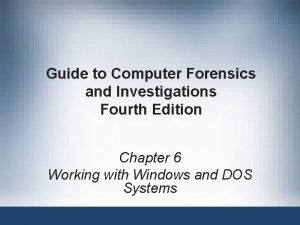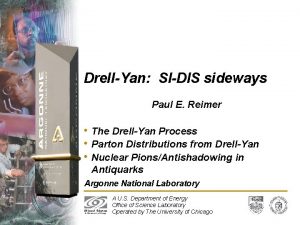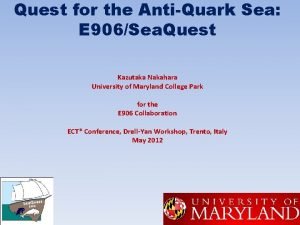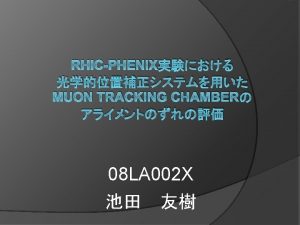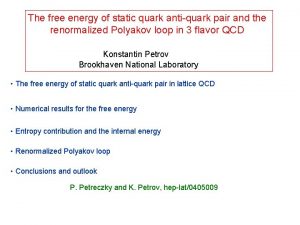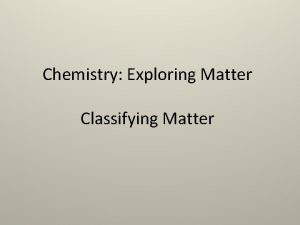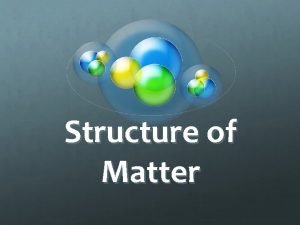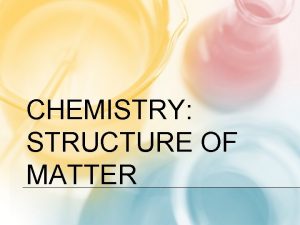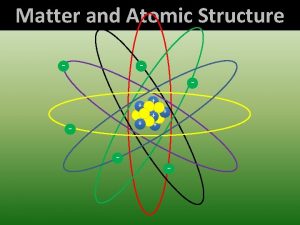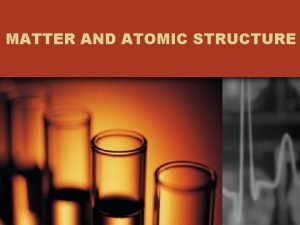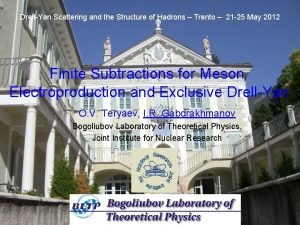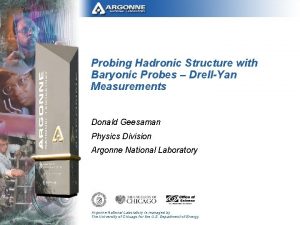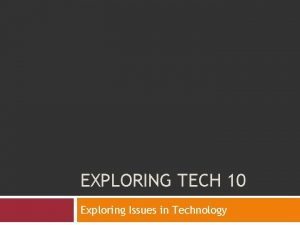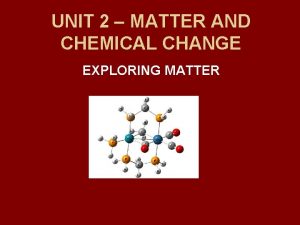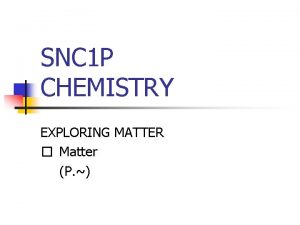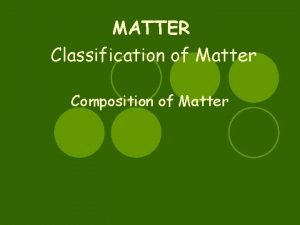Exploring the Antiquark Structure of Matter with DrellYan











































- Slides: 43

Exploring the Antiquark Structure of Matter with Drell-Yan Scattering: Fermilab E-906/Drell-Yan Paul E. Reimer Argonne National Laboratory Representing the Fermilab E 906/Drell Yan collaboration Why Drell-Yan? Where will we measure it? What will we learn? This work is supported in part by the U. S. Department of Energy, Office of Nuclear Physics, under Contract No. DE AC 02 06 CH 11357.

Why talk about Drell-Yan at JLab? e e * hadron proton n Similar Physics Goals – Parton level understanding of nucleon – Electromagnetic probe }X 10 June 2009 Paul E. Reimer Antiquark Structure with Drell-Yan JLab Users' Meeting 2

Why talk about Drell-Yan at JLab? e e * proton hadron proton }X 10 June 2009 + n Similar Physics Goals – Parton level understanding of nucleon – Electromagnetic probe n Differences – Timelike (Drell Yan) vs. spacelike (DIS) virtual photon. – Hadron beam and convolution of parton distributions (Drell Yan) – Factorazion/Hadronization (SI DIS) – Ability to select sea quark distributions Paul E. Reimer Antiquark Structure with Drell-Yan JLab Users' Meeting 3

C b ic La ph f J ra o G sy rte ou What’s in the proton? n Just three valence quarks? http: //www. sciencecartoonsplus. com/index. htm 10 June 2009 Paul E. Reimer Antiquark Structure with Drell-Yan JLab Users' Meeting 4

C b ic La ph f J ra o G sy rte ou What’s in the proton? n Just three valence quarks? n NO!! n And quark distributions change in a nucleus http: //www. sciencecartoonsplus. com/index. htm 10 June 2009 Paul E. Reimer Antiquark Structure with Drell-Yan JLab Users' Meeting 5

What is the distribution of sea quarks? In the nucleon: n Sea and gluons are important: – 98% of mass; 60% of momentum at Q 2 = 2 Ge. V 2 n Not just three valence quarks and QCD. Shown by E 866/Nu. Sea d bar/u bar data n What are the origins of the sea? n Significant part of LHC beam. CTEQ 6 m In nuclei: n The nucleus is not just protons and neutrons n What is the difference? – Bound system – Virtual mesons affects antiquarks distributions 10 June 2009 Paul E. Reimer Antiquark Structure with Drell-Yan JLab Users' Meeting 6

Simple view of parton distributions: A historic approach u g n Constituent Quark/Bag Model motivated valence approach – Use valence like (primordial) quark distributions at some very low scale, Q 2, perhaps a few hundred Me. V – Radiatively generate sea and glue. Gluck, Godbole, Reya, ZPC 41 667 (1989) n It was quickly realized that some valence like (primordial) sea was needed. Gluck, Reya, Vogt, ZPC 53, 127 (1992) – Driven by need to agree with BCDMS and EMC data – Assumption of symmetric sea remained 10 June 2009 Paul E. Reimer Antiquark Structure with Drell-Yan JLab Users' Meeting 7

Light Antiquark Flavor Asymmetry: Brief History n Naïve Assumption: 10 June 2009 Paul E. Reimer Antiquark Structure with Drell-Yan JLab Users' Meeting 8

Light Antiquark Flavor Asymmetry: Brief History n Naïve Assumption: n NMC (Gottfried Sum Rule) 10 June 2009 Paul E. Reimer Antiquark Structure with Drell-Yan JLab Users' Meeting 9

Light Antiquark Flavor Asymmetry: Brief History n Naïve Assumption: n NMC (Gottfried Sum Rule) NA 51 Drell Yan confirms d bar(x) > u bar(x) 10 June 2009 Paul E. Reimer Antiquark Structure with Drell-Yan JLab Users' Meeting 10

Light Antiquark Flavor Asymmetry: Brief History n Naïve Assumption: n NMC (Gottfried Sum Rule) n NA 51 (Drell Yan) n E 866/Nu. Sea (Drell Yan) n Knowledge of distributions is data driven – Sea quark distributions are difficult for Lattice QCD 10 June 2009 Paul E. Reimer Antiquark Structure with Drell-Yan JLab Users' Meeting 11

Light Antiquark Flavor Asymmetry: Brief History n Naïve Assumption: n NMC (Gottfried Sum Rule) n NA 51 (Drell Yan) n E 866/Nu. Sea (Drell Yan) n Knowledge of distributions is data driven – Sea quark distributions are difficult for Lattice QCD 10 June 2009 Paul E. Reimer Antiquark Structure with Drell-Yan JLab Users' Meeting 12

Proton Structure: By What Process Is the Sea Created? n There is a gluon splitting component which is symmetric n – Symmetric sea via pair production from gluons subtracts off – No Gluon contribution at 1 st order in s – Nonperturbative models are motivated by the observed difference n A proton with 3 valence quarks plus glue cannot be right at any scale!! 10 June 2009 Paul E. Reimer Antiquark Structure with Drell-Yan JLab Users' Meeting 13

Proton Structure: By What Process Is the Sea Created? n There is a gluon splitting component which is symmetric n – Symmetric sea via pair production from gluons subtracts off – No Gluon contribution at 1 st order in s – Nonperturbative models are motivated by the observed difference n A proton with 3 valence quarks plus glue cannot be right at any scale!! 10 June 2009 Paul E. Reimer Antiquark Structure with Drell-Yan JLab Users' Meeting 14

Models Relate Antiquark Flavor Asymmetry and Spin n Meson Cloud in the nucleon—Sullivan process in DIS h. P j. P i = (1 ¡ a ¡ b) h. P 0 j. P 0 i + ah. N 0 ¼j. N 0 ¼i + bh¢ 0 ¼j¢ 0 ¼i : : : n Chiral· Quark¸ models—effective Lagrangians hqjqi = 1¡ 3 a 3 a hqjqi + hq¼jq¼i 2 2 n Instantons L / u¹ R u. L d¹R d. L + u¹ L u. R d¹L d. R n Statistical Parton Distributions 10 June 2009 Paul E. Reimer Antiquark Structure with Drell-Yan JLab Users' Meeting 15

Models Relate Antiquark Flavor Asymmetry and Spin n Meson Cloud in the nucleon—Sullivan process in DIS h. P j. P i = (1 ¡ a ¡ b) h. P 0 j. P 0 i + ah. N 0 ¼j. N 0 ¼i + bh¢ 0 ¼j¢ 0 ¼i : : : Z £ ¤ 2 a ¡ b ¹ = 0: 10 ! a = 0: 2 = 2 b d(x) ¡ u¹ (x) = 3 1 0 Z g. A = 1 [¢ u ¡ ¢ d] dx = 0 5 20 p ¡ 2 ab ! 1: 5 3 27 n Chiral· Quark¸ models—effective Lagrangians hqjqi = Z 1¡ 3 a 3 a hqjqi + hq¼jq¼i 2 2 1£ 0 ¤ 2 a ¹ = 0: 10 ! ¡ u¹ (x) = d(x) 3 Z a = 0: 14 g. A = 0 1 [¢ u ¡ ¢ d] dx = 5 3 a ! 3 1: 43 n Instantons L / u¹ R u. L d¹R d. L + u¹ L u. R d¹L d. R 3 d¹I (x) ¡ u¹ I (x) = [¢ u. I (x) ¡ ¢ d. I (x)] 5 n Statistical Parton Distributions ¹ ¹ d(x) ¡ u¹ (x) ¼ ¢ u¹ (x) ¡ ¢ d(x) 10 June 2009 Paul E. Reimer Antiquark Structure with Drell-Yan JLab Users' Meeting 16

Proton Structure: By What Process Is the Sea Created? n Meson Cloud in the nucleon Sullivan process in DIS |pi = |p 0 i + |N i + | i +. . . n Chiral Models Interaction between Goldstone Bosons and valence quarks |ui!|d +i and |di!|u i Perturbative sea apparently dilutes meson cloud effects at large x, but this requires large-x gluons 10 June 2009 Paul E. Reimer Antiquark Structure with Drell-Yan JLab Users' Meeting 17

Proton Structure: By What Process Is the Sea Created? n Meson Cloud in the nucleon Sullivan process in DIS |pi = |p 0 i + |N i + | i +. . . n Chiral Models Interaction between Goldstone Bosons and valence quarks |ui!|d +i and |di!|u i Perturbative sea apparently dilutes meson cloud effects at large x 10 June 2009 Paul E. Reimer Antiquark Structure with Drell-Yan JLab Users' Meeting 18

Why talk about Drell-Yan at JLab? n Other possible answer Make Mont feel at home? 10 June 2009 Paul E. Reimer Antiquark Structure with Drell-Yan JLab Users' Meeting 19

Drell-Yan scattering: A laboratory for sea quarks Detector acceptance chooses xtarget and xbeam E M 906 on S te pe Ca ct rlo. xtarget n Fixed target ) high x. F = xbeam – xtarget n Valence Beam quarks at high x. n Sea target quarks at low/intermediate x. 10 June 2009 Paul E. Reimer Antiquark Structure with Drell-Yan JLab Users' Meeting 20

Advantages of 120 Ge. V Main Injector The (very successful) past: The future: Fermilab E 866/Nu. Sea Fermilab E 906 n Data in 1996 1997 n 1 H, 2 H, and nuclear targets n 800 Ge. V proton beam n Cross section scales as 1/s – 7£ that of 800 Ge. V beam n Backgrounds, primarily from J/ decays scale as s – 7£ Luminosity for same detector rate as 800 Ge. V beam 50£ statistics!! n Data in 2010 n 1 H, 2 H, and nuclear targets n 120 Ge. V proton Beam t rges a d T line e x Fi eam B Tevatron 800 Ge. V Main Injector 120 Ge. V n Limited Phase Space 10 June 2009 Paul E. Reimer Antiquark Structure with Drell-Yan JLab Users' Meeting 21

Iron et, d i l So agn r M g usin absorbe c o F ron ump d d a m H bea d n a n 1: e array o i t Sta scop ing o k Hod C trac P MW 4. 9 m d 3: n a y ion 2 pe arra cking t a t S osco mber tra d o H ha C t f i Dr as. e M. et) Mom Magn e. V (KT 25 m Hadron Absorber Drell-Yan Spectrometer for E-906 4: array n o i g e t Sta oscop trackin Hod tube p Pro Liquid H 2, d 2, and solid targets Solid iron magnet n Reuse SM 3 magnet coils n Sufficient Field with reasonable coils (amp turns) n Beam dumped within magnet 10 June 2009 Paul E. Reimer Antiquark Structure with Drell-Yan JLab Users' Meeting 22

Extracting d-bar/-ubar From Drell-Yan Scattering n E 906/Drell Yan will extend these measurements and reduce statistical uncertainty. n E 906 expects systematic uncertainty to remain at approx. 1% in cross section ratio. 10 June 2009 Paul E. Reimer Antiquark Structure with Drell-Yan JLab Users' Meeting 23

Structure of nucleonic matter: How do sea quark distributions differ in a nucleus? Alde et al (Fermilab E 772) Phys. Rev. Lett. 64 2479 (1990) n Intermediate x sea PDF’s absolute magnitude set by DIS on iron. – Are nuclear effects the same for the sea as for valence? – Are nuclear effects with the weak interaction the same as electromagnetic? n EMC: Parton distributions of bound and free nucleons are different. n Antishadowing not seen in Drell Yan—Valence only effect n What can the sea parton distributions tell us about the effects of nuclear binding? 10 June 2009 Paul E. Reimer Antiquark Structure with Drell-Yan JLab Users' Meeting 24

Structure of nucleonic matter: How do sea quark distributions differ in a nucleus? Comparison with Deep Inelastic Scattering (DIS) n EMC: Parton distributions of bound and free nucleons are different. n Antishadowing not seen in Drell Yan —Valence only effect 10 June 2009 Paul E. Reimer Antiquark Structure with Drell-Yan JLab Users' Meeting 25

Structure of nucleonic matter: How do sea quark distributions differ in a nucleus? Comparison with Deep Inelastic Scattering (DIS) n EMC: Parton distributions of bound and free nucleons are different. n Antishadowing not seen in Drell Yan —Valence only effect Alde et al (Fermilab E 772) Phys. Rev. Lett. 64 2479 (1990) 10 June 2009 Paul E. Reimer Antiquark Structure with Drell-Yan JLab Users' Meeting 26

Structure of nucleonic matter: Where are the nuclear pions? n The binding of nucleons in a nucleus is expected to be governed by the exchange of virtual “Nuclear” mesons. n No antiquark enhancement seen in Drell Yan (Fermilab E 772) data. n Contemporary models predict large effects to antiquark distributions as x increases. n Models must explain both DIS EMC effect and Drell Yan 10 June 2009 Paul E. Reimer Antiquark Structure with Drell-Yan JLab Users' Meeting 27

Structure of nucleonic matter: Where are the nuclear pions? n The binding of nucleons in a nucleus is expected to be governed by the exchange of virtual “Nuclear” mesons. n No antiquark enhancement seen in Drell Yan (Fermilab E 772) data. n Contemporary models predict large effects to antiquark distributions as x increases. n Models must explain both DIS EMC effect and Drell Yan 10 June 2009 Paul E. Reimer Antiquark Structure with Drell-Yan JLab Users' Meeting 28

Structure of nucleonic matter: Where are the nuclear pions? n The binding of nucleons in a nucleus is expected to be governed by the exchange of virtual “Nuclear” mesons. n No antiquark enhancement seen in Drell Yan (Fermilab E 772) data. n Contemporary models predict large effects to antiquark distributions as x increases. n Models must explain both DIS EMC effect and Drell Yan 10 June 2009 Paul E. Reimer Antiquark Structure with Drell-Yan JLab Users' Meeting 29

Structure of nucleonic matter: Where are the nuclear pions? n The binding of nucleons in a nucleus is expected to be governed by the exchange of virtual “Nuclear” mesons. n No antiquark enhancement seen in Drell Yan (Fermilab E 772) data. n Contemporary models predict large effects to antiquark distributions as x increases. n Models must explain both DIS EMC effect and Drell Yan 10 June 2009 Paul E. Reimer Antiquark Structure with Drell-Yan JLab Users' Meeting 30

E 906/Drell-Yan timeline n Fermilab PAC approved the experiment in 2001, but experiment was not scheduled due to concerns about “proton economics” n Spectrometer upgrade funded by DOE/Office of Nuclear Physics (already received $700 k by FY 09) n Fermilab PAC reaffirms earlier decision in Fall 2006 n Scheduled to run in 2010 for 2 years of data collection n Apparatus available for future programs at, e. g. Fermilab, J PARC or RHIC – Significant interest from collaboration for continued program Expt. Funded Experiment Construction 2012 2011 2010 2009 2008 10 June 2009 Experiment Runs Paul E. Reimer Antiquark Structure with Drell-Yan JLab Users' Meeting 31

FNAL E 866/Nu. Sea Collaboration Louisiana State University Abilene Christian University Donald Isenhower, Mike Sadler, Rusty Towell, Paul Kirk, Ying Chao Wang, Zhi Fu Wang Josh Bush, Josh Willis, Derek Wise New Mexico State University Argonne National Laboratory Mike Beddo, Ting Chang, Gary Kyle, Don Geesaman, Sheldon Kaufman, Vassilios Papavassiliou, J. Seldon, Naomi Makins, Bryon Mueller, Paul E. Reimer Jason Webb Fermi National Accelerator Laboratory Chuck Brown, Bill Cooper Georgia State University Gus Petitt, Xiao chun He, Bill Lee Illinois Institute of Technology Dan Kaplan Oak Ridge National Laboratory Terry Awes, Paul Stankus, Glenn Young Texas A & M University Carl Gagliardi, Bob Tribble, Eric Hawker, Maxim Vasiliev Los Alamos National Laboratory Melynda Brooks, Tom Carey, Gerry Garvey, Dave Lee, Mike Leitch, Pat Mc. Gaughey, Joel Moss, Brent Park, Jen Chieh Peng, Andrea Palounek, Walt Sondheim, Neil Thompson 10 June 2009 Valparaiso University Don Koetke, Paul Nord Paul E. Reimer Antiquark Structure with Drell-Yan JLab Users' Meeting 32

Fermilab E 906/Drell-Yan Collaboration Abilene Christian University Donald Isenhower, Mike Sadler, Rusty Towell, Shon Watson Academia Sinica Wen Chang, Yen Chu Chen, Da Shung Su Argonne National Laboratory John Arrington, Don Geesaman*, Kawtar Hafidi, Roy Holt, Harold Jackson, David Potterveld, Paul E. Reimer*, Patricia Solvignon University of Colorado Ed Kinney Fermi National Accelerator Laboratory Chuck Brown, Dave Christian Ling Tung University Ting Hua Chang Los Alamos National Laboratory Gerry Garvey, Xiaodong Jaing, Mike Leitch, Ming Liu, Pat Mc. Gaughey, Joel Moss University of Maryland Prabin Adhikari, Betsy Beise, Kazutaka Nakahara University of Michigan Wolfgang Lorenzon, Richard Raymond RIKEN Yuji Goto, Atsushi Taketani, Yoshinori Fukao, Manabu Togawa University of Illinois Naomi C. R Makins, Jen Chieh Peng Rutgers University Lamiaa El Fassi, Ron Gilman, Charles Glashausser, Elena Kuchina, Ron Ransome, Elaine Schulte KEK Shin'ya Sawada Texas A & M University Carl Gagliardi, Robert Tribble Kyoto University Ken. Ichi Imai, Tomo Nagae Thomas Jefferson National Accelerator Facility Dave Gaskell *Co Spokespersons 10 June 2009 Tokyo Institute of Technology Toshi Aki Shibata, Yoshiyuki Miyachi Paul E. Reimer Antiquark Structure with Drell-Yan JLab Users' Meeting 33

Additional Physics from beam parton distributions n High x. Bj Valence quark distributions n Partonic energy loss in cold nuclear matter Unpolarized Angular distributions n Lam Tung Relation 1 ¡ ¸ = 2º d¾ º 2 / 1 + ¸ cos µ + ¹ sin 2µcosÁ + sin 2 µcos 2Á 2 d n Boer Mulders Distributions Possible future programs n Polarized target of beam n Pionic Drell Yan 10 June 2009 Fermilab E 866/Nu. Sea Paul E. Reimer Antiquark Structure with Drell-Yan JLab Users' Meeting 34

Drell-Yan at Fermilab n Drell-Yan scattering is uniquely sensitive to the antiquark distributions of the target. n The E-906/Drell-Yan Collaboration is constructing a facility to measure Drell. Yan Scattering. n E-906/Drell-Yan will use this to measure – the ration of anti-d to anti -u distributions in the proton, – The modifications to the quark sea in a nucleus, and – Many more interesting topics This work is supported in part by the U. S. Department of Energy, Office of Nuclear Physics, under Contract No. DE AC 02 06 CH 11357. 10 June 2009 Paul E. Reimer Antiquark Structure with Drell-Yan JLab Users' Meeting 35

Additional Material 10 June 2009 Paul E. Reimer Antiquark Structure with Drell-Yan JLab Users' Meeting 36

I don’t have an answer, but you’ve sure given me a lot to think about 10 June 2009 Paul E. Reimer Antiquark Structure with Drell-Yan JLab Users' Meeting 37

Drell-Yan Acceptance n Programmable trigger removes likely J/ events n Transverse momentum acceptance to above 2 Ge. V n Spectrometer could also be used for J/ , 0 studies Mass 10 June 2009 xtarget xbeam x. F Paul E. Reimer Antiquark Structure with Drell-Yan JLab Users' Meeting 38

Detector Resolution 240 Me. V Mass Res. 0. 04 x 2 Res. n Triggered Drell Yan events 10 June 2009 Paul E. Reimer Antiquark Structure with Drell-Yan JLab Users' Meeting 39

Drell-Yan Cross Section Ratio and d-bar/u-bar 10 June 2009 Paul E. Reimer Antiquark Structure with Drell-Yan JLab Users' Meeting 40

Drell-Yan Scattering: What we really measure n Measure yields of + pairs from different targets n For each event measure 3 momentum of each n Assume that it is a muon to get 4 momentum 10 June 2009 n Reconstruct M 2 , p. T , p|| n M 2 = x 1 x 2 s, n x. F = 2 p|| /s 1/2 ≈ x 1 – x 2 Paul E. Reimer Antiquark Structure with Drell-Yan JLab Users' Meeting 41

Next-to-Leading Order Drell-Yan n Next to leading order diagrams complicate the picture n These diagrams are responsible for 50% of the measured cross section n Intrinsic transverse momentum of quarks (although a small effect, l > 0. 8) 10 June 2009 Paul E. Reimer Antiquark Structure with Drell-Yan JLab Users' Meeting 42

Drell-Yan Mass Spectra 10 June 2009 Data From Fermilab E 866/Nu. Sea 800 Ge. V proton beam on hydrogen target Edge of Spectrometer Acceptance Paul E. Reimer Antiquark Structure with Drell-Yan JLab Users' Meeting 43
 Forensics
Forensics Classification of matter section 1 composition of matter
Classification of matter section 1 composition of matter Gray and white matter
Gray and white matter Composition of matter section 1
Composition of matter section 1 Chapter 2 section 1 classifying matter answer key
Chapter 2 section 1 classifying matter answer key Label the cranial dura septa and associated sinuses.
Label the cranial dura septa and associated sinuses. Composition of matter section 1
Composition of matter section 1 Gray matter and white matter
Gray matter and white matter Telencephalon
Telencephalon Ecological succession
Ecological succession Hát kết hợp bộ gõ cơ thể
Hát kết hợp bộ gõ cơ thể Bổ thể
Bổ thể Tỉ lệ cơ thể trẻ em
Tỉ lệ cơ thể trẻ em Voi kéo gỗ như thế nào
Voi kéo gỗ như thế nào Glasgow thang điểm
Glasgow thang điểm Alleluia hat len nguoi oi
Alleluia hat len nguoi oi Các môn thể thao bắt đầu bằng tiếng bóng
Các môn thể thao bắt đầu bằng tiếng bóng Thế nào là hệ số cao nhất
Thế nào là hệ số cao nhất Các châu lục và đại dương trên thế giới
Các châu lục và đại dương trên thế giới Công của trọng lực
Công của trọng lực Trời xanh đây là của chúng ta thể thơ
Trời xanh đây là của chúng ta thể thơ Cách giải mật thư tọa độ
Cách giải mật thư tọa độ 101012 bằng
101012 bằng Phản ứng thế ankan
Phản ứng thế ankan Các châu lục và đại dương trên thế giới
Các châu lục và đại dương trên thế giới Thể thơ truyền thống
Thể thơ truyền thống Quá trình desamine hóa có thể tạo ra
Quá trình desamine hóa có thể tạo ra Một số thể thơ truyền thống
Một số thể thơ truyền thống Cái miệng nó xinh thế
Cái miệng nó xinh thế Vẽ hình chiếu vuông góc của vật thể sau
Vẽ hình chiếu vuông góc của vật thể sau Biện pháp chống mỏi cơ
Biện pháp chống mỏi cơ đặc điểm cơ thể của người tối cổ
đặc điểm cơ thể của người tối cổ Thế nào là giọng cùng tên?
Thế nào là giọng cùng tên? Vẽ hình chiếu đứng bằng cạnh của vật thể
Vẽ hình chiếu đứng bằng cạnh của vật thể Tia chieu sa te
Tia chieu sa te Thẻ vin
Thẻ vin đại từ thay thế
đại từ thay thế điện thế nghỉ
điện thế nghỉ Tư thế ngồi viết
Tư thế ngồi viết Diễn thế sinh thái là
Diễn thế sinh thái là Dạng đột biến một nhiễm là
Dạng đột biến một nhiễm là Số nguyên tố là số gì
Số nguyên tố là số gì Tư thế ngồi viết
Tư thế ngồi viết
